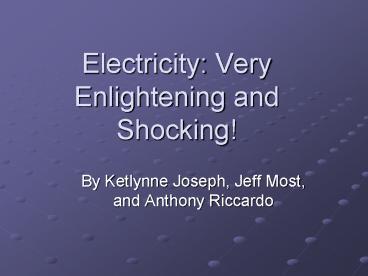Electricity: Very Enlightening and Shocking - PowerPoint PPT Presentation
1 / 21
Title:
Electricity: Very Enlightening and Shocking
Description:
Time needed: 1-2 class periods, Approximately 75-90 minutes ... observe and describe the properties of sound, light, magnetism, and electricity. ... – PowerPoint PPT presentation
Number of Views:72
Avg rating:3.0/5.0
Title: Electricity: Very Enlightening and Shocking
1
Electricity Very Enlightening and Shocking!
- By Ketlynne Joseph, Jeff Most, and Anthony
Riccardo
2
Topic Static Electricity, How is it Generated.
- Grade level/s Intermediate 6-8
- Time needed 1-2 class periods, Approximately
75-90 minutes
3
Science or Math background material for the
teacher
- Teacher Background on Electricity Basics
- http//www.eia.doe.gov/kids/energyfacts/sources/el
ectricity.html - Ben Franklin Stuffhttp//www.fi.edu/learn/sci-te
ch/lightning-rod/lightning-rod.php?ctsbenfranklin
-weather-electricity
4
Instructional Objectives
- To explain how objects can receive a static
electrical charge. - To describe the effects of bringing objects with
like and unlike charges near one another. - To compare conductors and insulators.
- To identify and diagram a series circuit and a
parallel circuit.
5
Standards met by this Lesson
- Learning Standards for Mathematics, Science, and
Technology Standard 4 Intermediate Physical
Setting - 4. Energy exists in many forms, and when these
forms change energy is conserved. - Students
- describe the sources and identify the
transformations of energy observed in everyday
life. - observe and describe heating and cooling events.
- observe and describe energy changes as related to
chemical reactions. - observe and describe the properties of sound,
light, magnetism, and electricity. - describe situations that support the principle of
conservation of energy. - This is evident, for example, when students-
design and construct devices to
transform/transfer energy.- build an
electromagnet and investigate the effects of
using different types of core materials, varying
thicknesses of wire, and different circuit types.
6
Materials
- T.V. set,
- string,
- chalk,
- balloons,
- thread,
- chalkboard,
- water sprayer,
- size D batteries,
- battery clips and holders,
- small bulbs (41 48)
- sockets for small bulbs
- copper wire
- objects to test as conductors
- paper clips
- strands of steel wool.
- wool cloth,
7
Students will watch Greatest Moments in
Science History
8
Procedure
- Groups will be assigned to complete one of the
following investigations. Once complete they will
present their findings using either chart paper
and/or PowerPoint presentations.
9
Group Option 1
- The students will perform the following
activities to understand how objects receive a
static electrical charge Let the string hang
about one inch from the front of the T.V. set.
When the television is turned on, the string will
be repelled or attracted to the television
screen. Students will inflate several balloons.
They will rub the balloons with a wool cloth to
create an electrically charged surface. These
balloons will cling to the classroom ceiling and
to a chalk drawing of a shelf on the chalkboard.
10
Advance Organizer Example
11
Group Option 2
- The students will perform the following
activities to understand the effects of bringing
objects with like and unlike charges near one
another Students will inflate two balloons to
the same size and tie a string to each balloon.
Both balloons will be given negative charges by
rubbing them with a wool cloth. They will repel
one another. Next, one of the balloons will be
given a positive charge. This balloon will be
attracted to the negatively charged balloon. The
balloons will be sprayed with water to neutralize
them.
12
Group Option 3
- The students will perform the following
activities to compare conductors and insulators
Using a simple series circuit with one small
bulb, each student will test objects to observe
which materials permit a flow of electrons
(conductors) and which materials do not permit a
flow of electrons (insulators). Each student
will list items tested and test results on a
chart.
13
Group Option 4
- The students will perform the following
activities to understand series and parallel
circuits After learning how to read a circuit
diagram, each student will construct a series
circuit and a parallel circuit. The students
will make observations about what happens when
one bulb is removed from each of the different
types of circuits. They will also observe which
circuits have brighter bulbs.
14
Circuits
- Series Circuit
- Parallel Circuit
15
Discussion Questions
- After a group has completed their presentation,
questions and discussion will be generated from
fellow students. Group will be required to answer
them. Teacher to facilitate the question and
answer period.
16
Closure
- Groups will display their investigative and
experimental findings to the rest of the class
based on which activity they were assigned on the
bulletin board.
17
Multicultural Connections
- All cultures experience static electricity the
same way. - Students can research Physical Scientists or
Inventors native to their country of origin.
18
Possible ways technology might be incorporated
- Computers are to be used. Software such as
Microsoft Office will be utilized by the
students, more specifically PowerPoint, Excel,
and Word.
19
Assessment
- 1. Using a diagram and sentences, explain how
lightning is a form of static electricity. - 2. What type of circuits are used in buildings?
Explain. - 3. Describe a safety device that is used as part
of a circuit. Explain how it works.
20
Extension activities
- Web Activities.
- Science Expo.
21
Bibliography/References
- http//www.fi.edu/learn/sci-tech/lightning-rod/lig
htning-rod.php?ctsbenfranklin-weather-electricity
- http//www.iit.edu/smile/ph9213.html































